Update on Our Summer Interns: New Canaan Land Trust’s Summer Session 1
Our session 1 team of interns has been quite busy since our last update! As of now, the first installment of our two-part summer program is complete. Over the previous three weeks Anna, Cooper, Elle, Jose, and Ned accomplished a tremendous amount. From working on the preserves to interacting with workshop opportunities, traveling to different environmentally-oriented initiative locations, saying goodbye to Jose, and saying hello to Matthew, the NCLT 2022 Internship Program never encountered a dull moment!
A core component of the Land Trust internship program is fostering relationships with the natural world through stewardship. Our ongoing approach to this is through conscious care of natural spaces for both the local wildlife as well as for the residents of New Canaan. This conservational approach means that we were performing a variety of tasks on any given day. There is no short supply of activities to be done. Some of our most important regular tasks involve watering gardens, general trail maintenance, pruning overgrowth, maintaining rock wall integrity, and removal of invasives. The interns were introduced to some true work efforts as we spent our days outdoors in the elements. The success of this first program can be attributed to the positive attitudes and tremendous meaningful effort put forth by each member of our program: Anna, Cooper, Elle, Jose, Matthew, and Ned.
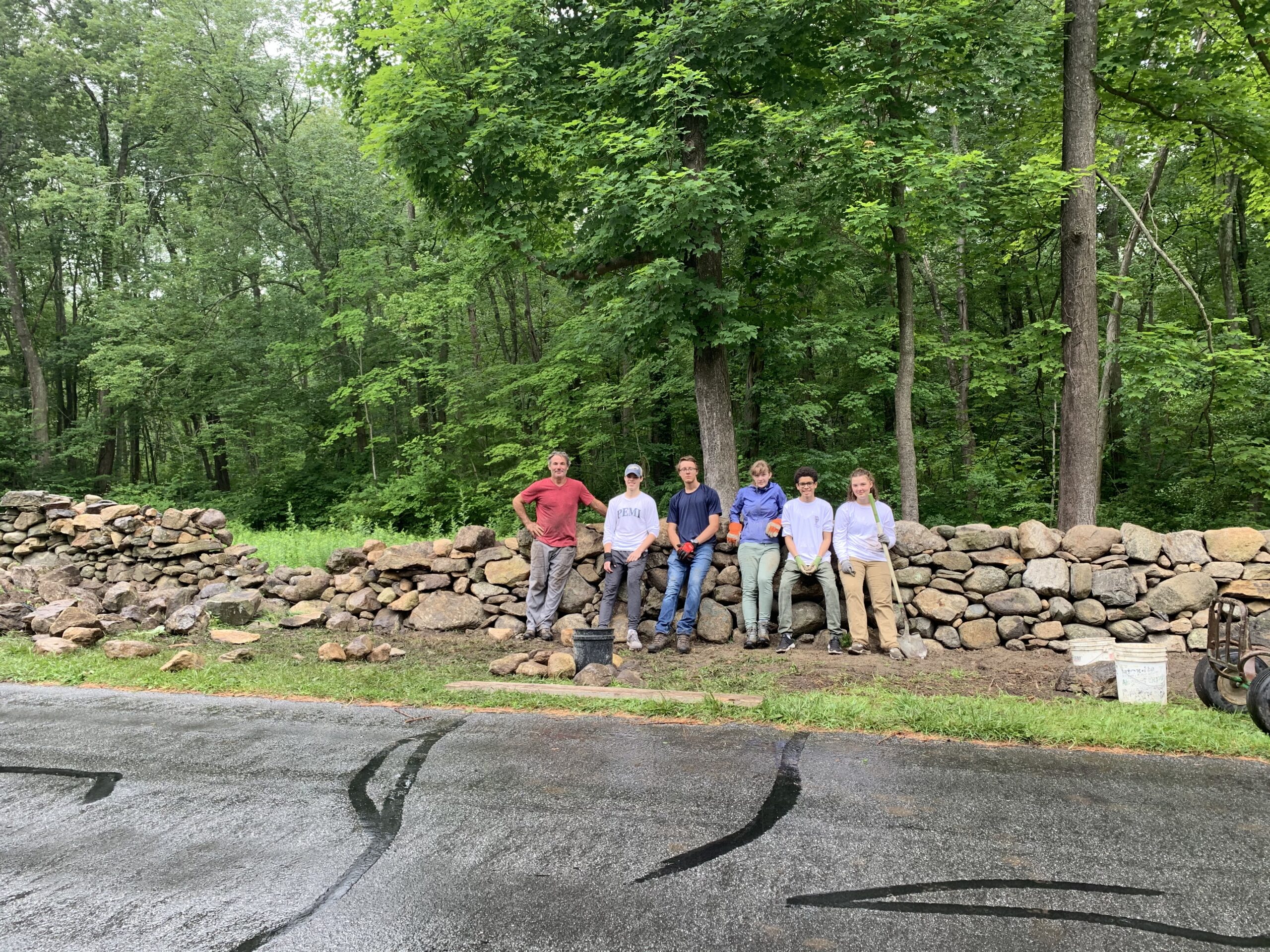
Week 2: Stone Wall Building…Removing Invasives…Field Trip…Trail Improvements
We began week two with our first workshop. A friend of the Land Trust, Greg Faillaci, was kind enough to lend his time and skill to educate our group on stone wall building. We spent the morning tearing away old segments of a wall to rebuild a stronger structure that would stand the test of time. Greg shared key knowledge of how to build a stable and sound structure by utilizing stones of different sizes and working existing angles to our advantage. The result was a beautifully constructed segment of the wall; the building of which was no small feat. The interns all were essential contributors to the day’s successes.
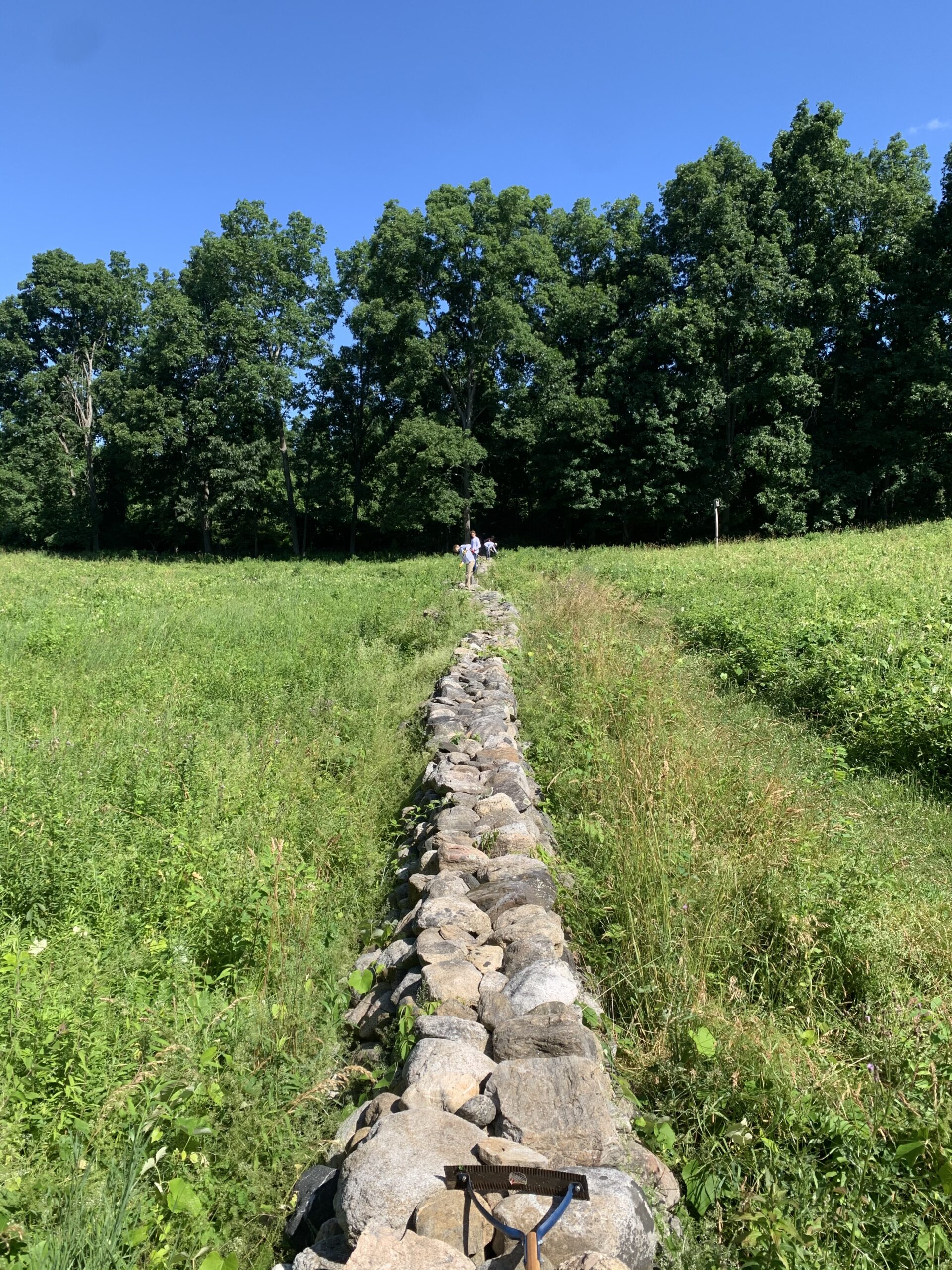 As the week progressed, time was spent at Livingston-Higley Preserve, Browne Preserve, Colhoun Preserve, and Silvermine-Fowler. The key project at Livingston-Higley was removing encroaching vines from our featured rock wall in the center of the property’s meadow. This is an essential routine practice to maintain the structural integrity of the rock wall as well as to preserve the natural beauty of that stone fence; a classic reminder of the history of New England. Furthermore, by doing this we can maintain the biodiversity of our meadows and support the abundance of local pollinators. At Browne Preserve we worked to manage the progression of Burning Bush shoots. Burning Bush, Euonymus alatus, is a non-native invasive species that can begin to dominate in the understory shrub layer of a forest. Their success can come at the detriment of the native species that we hope to promote. Thus we worked to remove many of these shoots so that they may not prevail at this property. There is always work to be done with invasive species.
As the week progressed, time was spent at Livingston-Higley Preserve, Browne Preserve, Colhoun Preserve, and Silvermine-Fowler. The key project at Livingston-Higley was removing encroaching vines from our featured rock wall in the center of the property’s meadow. This is an essential routine practice to maintain the structural integrity of the rock wall as well as to preserve the natural beauty of that stone fence; a classic reminder of the history of New England. Furthermore, by doing this we can maintain the biodiversity of our meadows and support the abundance of local pollinators. At Browne Preserve we worked to manage the progression of Burning Bush shoots. Burning Bush, Euonymus alatus, is a non-native invasive species that can begin to dominate in the understory shrub layer of a forest. Their success can come at the detriment of the native species that we hope to promote. Thus we worked to remove many of these shoots so that they may not prevail at this property. There is always work to be done with invasive species.
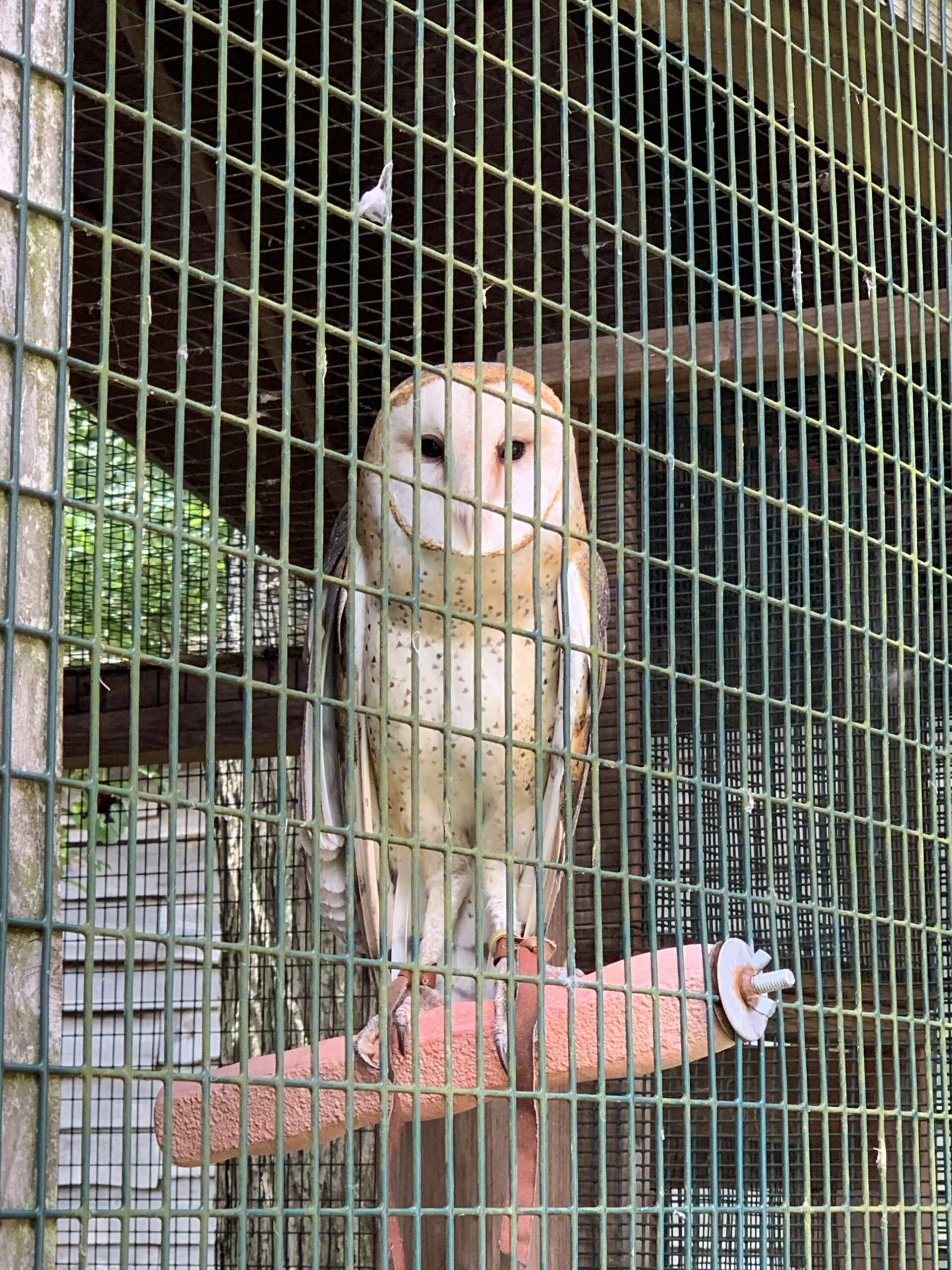 The Wednesday field trip this week was at Fairfield Audubon Society. Unfortunately, due to Covid-19, our “meet the animals” program did not work out as intended. However, this did not dissuade our team. We still visited the Audubon land and spent the morning exploring their extensive trail systems as well as interacting with their outdoor birds of prey exhibit. The remainder of our day was spent at the 170-acre open space property in Fairfield called Lake Mohegan. We traversed the variety of terrains featured at this site and did journaling activities interacting with the environment around us. The day’s activities made out for a successful and educational experience.
The Wednesday field trip this week was at Fairfield Audubon Society. Unfortunately, due to Covid-19, our “meet the animals” program did not work out as intended. However, this did not dissuade our team. We still visited the Audubon land and spent the morning exploring their extensive trail systems as well as interacting with their outdoor birds of prey exhibit. The remainder of our day was spent at the 170-acre open space property in Fairfield called Lake Mohegan. We traversed the variety of terrains featured at this site and did journaling activities interacting with the environment around us. The day’s activities made out for a successful and educational experience.
To finish out the week our time was spent at Colhoun and Silvermine-Fowler Preserves. At Colhoun we improved various areas needing remedies in trail lining and we also worked on cutting back of overgrowth surrounding the meadows. At Silvermine-Fowler we closed out the remainder of our Friday constructing brush piles with cuttings of large invasive burning bush plants. Brush piles work to prevent the re-establishment of these cuttings by removing growth options while promoting habitat for smaller animals that will take advantage of the heaps. Unfortunately, we had to end our second week by saying goodbye to Jose who needed to return home to New York. Though his time may have been cut short, his efforts through the first two weeks were tremendous and his positive attitude was always to be appreciated. We were all quite shocked as to how quickly our halfway point of the session had arrived. With week 2 under our belts, the team was well on our way with the program.
Week 3: Watering…Field Trip…Trail Maintenance…Pollinator Workshop
Our third week of the program was a little different, we began with Monday off due to overlap with the 4th of July. After an enjoyable weekend, Tuesday had arrived and we were right back into the swing of things. A new face, Matthew Riley, joined our group and quickly became a valuable addition to our operation. Matthew has worked with the internship program previously and was eager to rejoin this year’s efforts. Over the weekend prior to week 3, we had been anticipating rain, which proved to never arrive. While this made for great holiday-weekend weather, some of our newer plantings in the Still Pond meadow were left a bit thirsty. Our main Tuesday objective was to get the meadow watered. This involved a group effort to load our empty 300-gallon water tank onto our NCLT truck and bring it over to the friendly folks at the New Canaan Fire Department. Here they were able to quickly replenish the water levels and then it was back to Still Pond to get to business. Since we had such a significant amount of water and area to cover, utilizing basic garden hose physics was not going to cut it when it was watering time. Thankfully, our team has access to a powered pump that makes this sort of job much easier. We made sure the pump was primed, reviewed the proper starting procedure, connected all the hosing, and proceeded to disperse the water across our newer plantings. The meadow restoration is an ongoing project, making sure adequate water is provided to our shrubs and herbaceous plants in the area is key for successful establishment. On Wednesday, once again, we embarked on a field trip to another location. This week’s excursion location was SoundWaters, located in Stamford. This group’s goal is to protect the Long Island Sound through education. We prefaced the trip by discussing our properties and the significance of watersheds in our communities and the well-being of the Long Island Sound. We also reviewed some informative videos pertaining to the formation of the Long Island Sound from previous glacier events. With that information fresh in mind, we ventured to their location at Cove Island Park and met Autumn who would be our educator for the day. The group geared up in waders and was given nets. We spent time utilizing these handheld nets as well as two-person seining nets to collect various organisms for closer evaluation. From pipefish, to shore crab, to flounder, there was a vast diversity of species in the low tide shallows. Autumn was kind enough to share her knowledge of each species, their interactions with one another, and how each contributes to the various ecosystems within the Long Island Sound. After our program, we spent the remainder of the day exploring the grounds of the park and taking note of various findings as we went along.
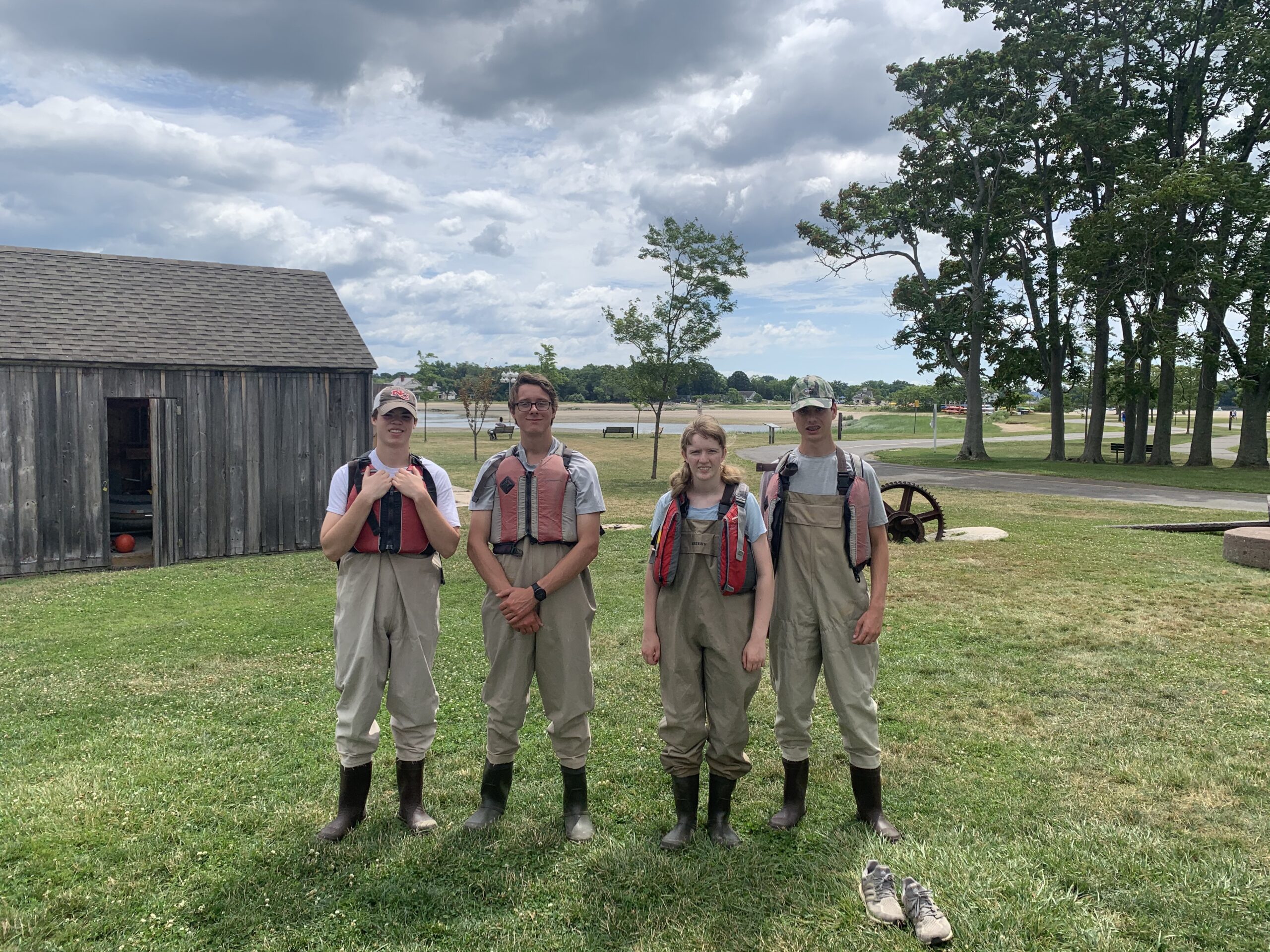
This excursion was a valuable change up from our typical surroundings, it provided insight as to where the water we see flowing on our properties ultimately ends up and helped establish a larger understanding of the interconnectedness of the natural world. The following Thursday we returned to some of our properties. We dedicated this day to maintaining our various GreenLink Trails. These three trails are regularly frequented by members of the community, so general trail maintenance was required to ensure continued enjoyment of these natural spaces. Additionally, we visited all the stops on our sculpture trail to place interactive and informative signs for each piece. Each sculpture is accompanied by an audio explanation from the artist themselves. These explanations can be heard as you approach the sculptures when utilizing the Otocast app. This application shows where each sculpture is geographically and can be a valuable resource for any interested individual.
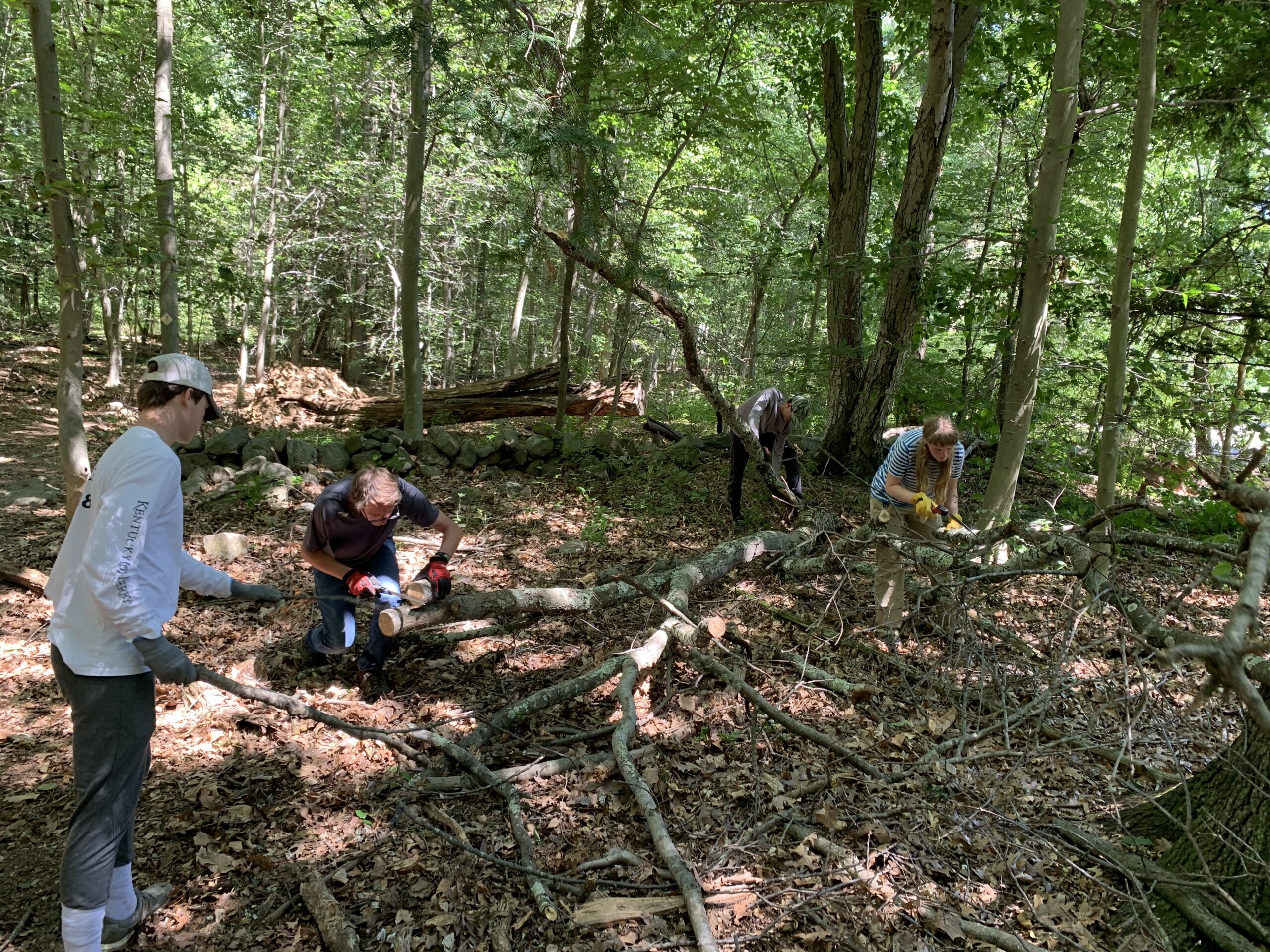
The team worked together to remove a hanging limb and dispose from the path
We finished off the week with a workshop back at the Still Pond meadow given by Susan Bergen. Susan has an abundance of knowledge on pollinators and the value of meadows, which she was kind enough to share with us. After our discussion, we did some weeding within the meadow to ensure support for our desired plantings. We finished out the day and week at Hicks Meadow. Here we cleared out overgrowth on the inside perimeter of the featured stone wall as well as maintained the roadside growth as well. Our goal was to enhance the aesthetic value created by the stone wall while also supporting its structural integrity by removing encroaching vines and invasive species. As the week closed out, everyone was in agreement that the program seemed to be flying by as we rounded the corner into our final week.
Week 4: Upcycling…Stone Wall Maintenance…Field Trip…Brush Piles
The final week of our internship program had arrived out of nowhere. Anna, Cooper, Elle, and Ned arrived at the office Monday morning for our last workshop; Matthew had to attend a Boy Scout camp this week and will return for our second session. We were lucky enough to hear from Carol Paik, an artist who utilizes materials that would otherwise be discarded to create her pieces. Her visit was prefaced with videos and discussions pertaining to fast fashion, one of the most polluting industries in the world, and the environmental impacts of other mass consumer industries. Carol shared some insights about seeing the potential in items others would simply get rid of. She shared her various works in person and engaged the interns in discussions about their own personal relationships with artistry and encouraged our team to take a new view on some of the discarded materials we find on our properties. This experience was a unique opportunity to encourage thought on wastefulness and the longevity of items after they become discarded.
After our workshop time, we moved to Hannan Field. Here we began to cut a two-foot perimeter on the inside of the expansive stone wall. This was a substantial task as the wall, found at the corner of Smith Ridge Road and Canoe Hill Road, spans across the entire outer perimeter of this meadow. This involved removal of vines and overgrowth to maintain the structural integrity of this impressive stone wall. This sort of meadow and stone wall maintenance became our agenda for the beginning of the week. We finished up at Hannan Field the following Tuesday and completed similar efforts at Colhoun Preserve to end that day. Each of these sites displays a stone wall. We want to ensure that these walls remain standing for years to come as well as promote their beauty as classic features of New England. With these tasks completed, we were ready for our final excursion as Wednesday arrived.
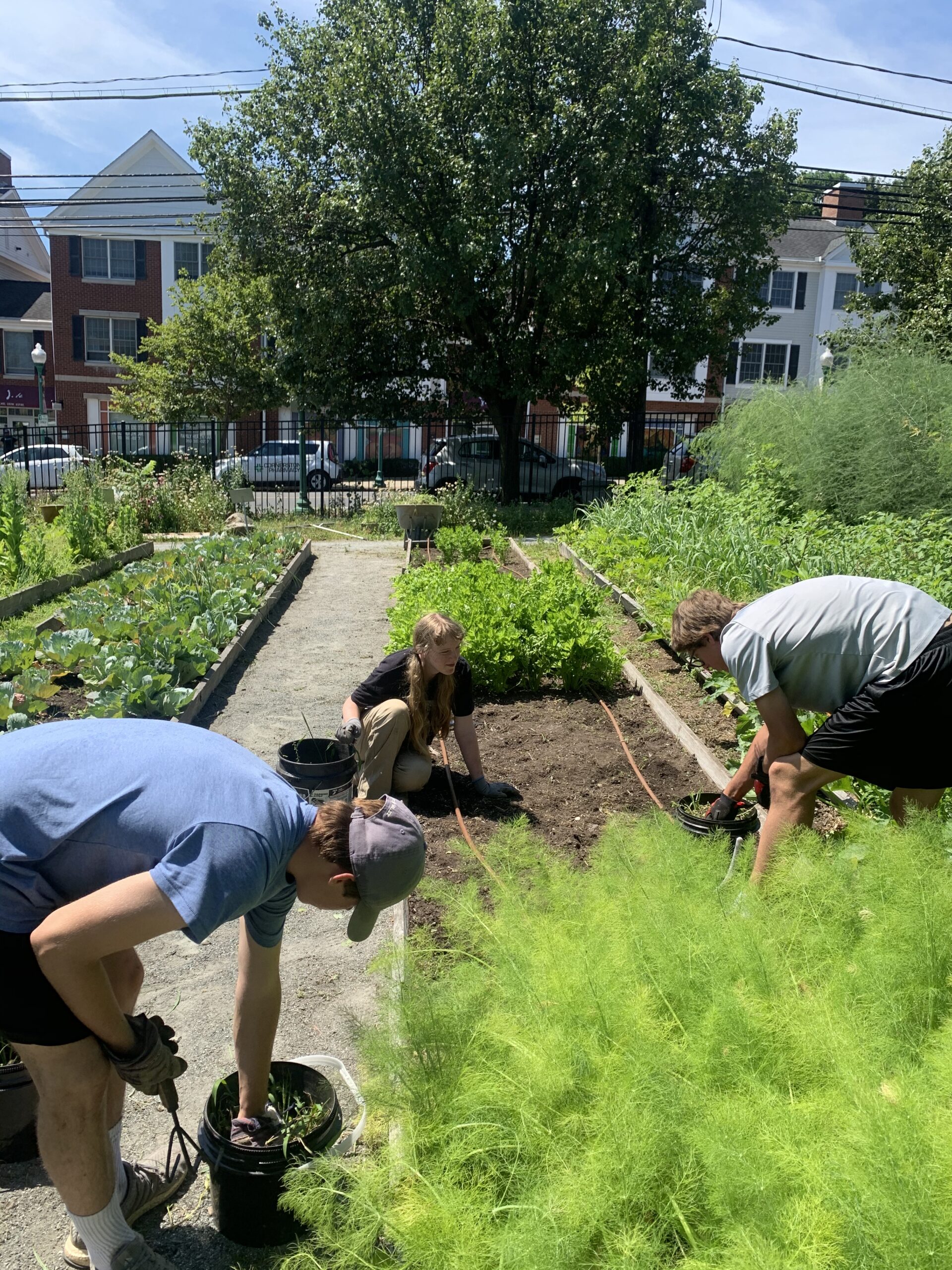 Our group traveled to Fairgate Farm, which is an urban farming operation utilizing all the space and volunteer support available to them. They grow a variety of produce and support their community by donating a substantial amount of every harvest. Our time was spent learning about their operations, clearing raised beds of weeds, as well as harvesting over a hundred pounds of garlic plantings; interns were allowed to take some of the harvest home with them! We spent half the day contributing our time here then moved to the Stamford Museum and Nature Center to continue our excursion. Here we reviewed a glimpse at livestock farming in New England with their featured animals and barns. After this, we spent time exploring their expansive trail systems and returned to the office to end the day.
Our group traveled to Fairgate Farm, which is an urban farming operation utilizing all the space and volunteer support available to them. They grow a variety of produce and support their community by donating a substantial amount of every harvest. Our time was spent learning about their operations, clearing raised beds of weeds, as well as harvesting over a hundred pounds of garlic plantings; interns were allowed to take some of the harvest home with them! We spent half the day contributing our time here then moved to the Stamford Museum and Nature Center to continue our excursion. Here we reviewed a glimpse at livestock farming in New England with their featured animals and barns. After this, we spent time exploring their expansive trail systems and returned to the office to end the day.
Thursday was spent visiting several of our properties. With the end of the program looming overhead, we wanted to revisit some of our past projects, add various improvements along the lines of general trail maintenance and provide the interns an opportunity to provide input for the second internship session. Ultimately our final day arrived, the program seemed to have gone by in a blink. The interns returned to Silvermine-Fowler for our final morning. We spent time doing as we did at the very beginning of the session and removed some substantial Burning Bush growth and established brush piles. We did this until about noon and then switched gears. As thanks for a job well done we ventured to Pinocchio’s Pizza in town and enjoyed an extra large pepperoni pizza as a group.
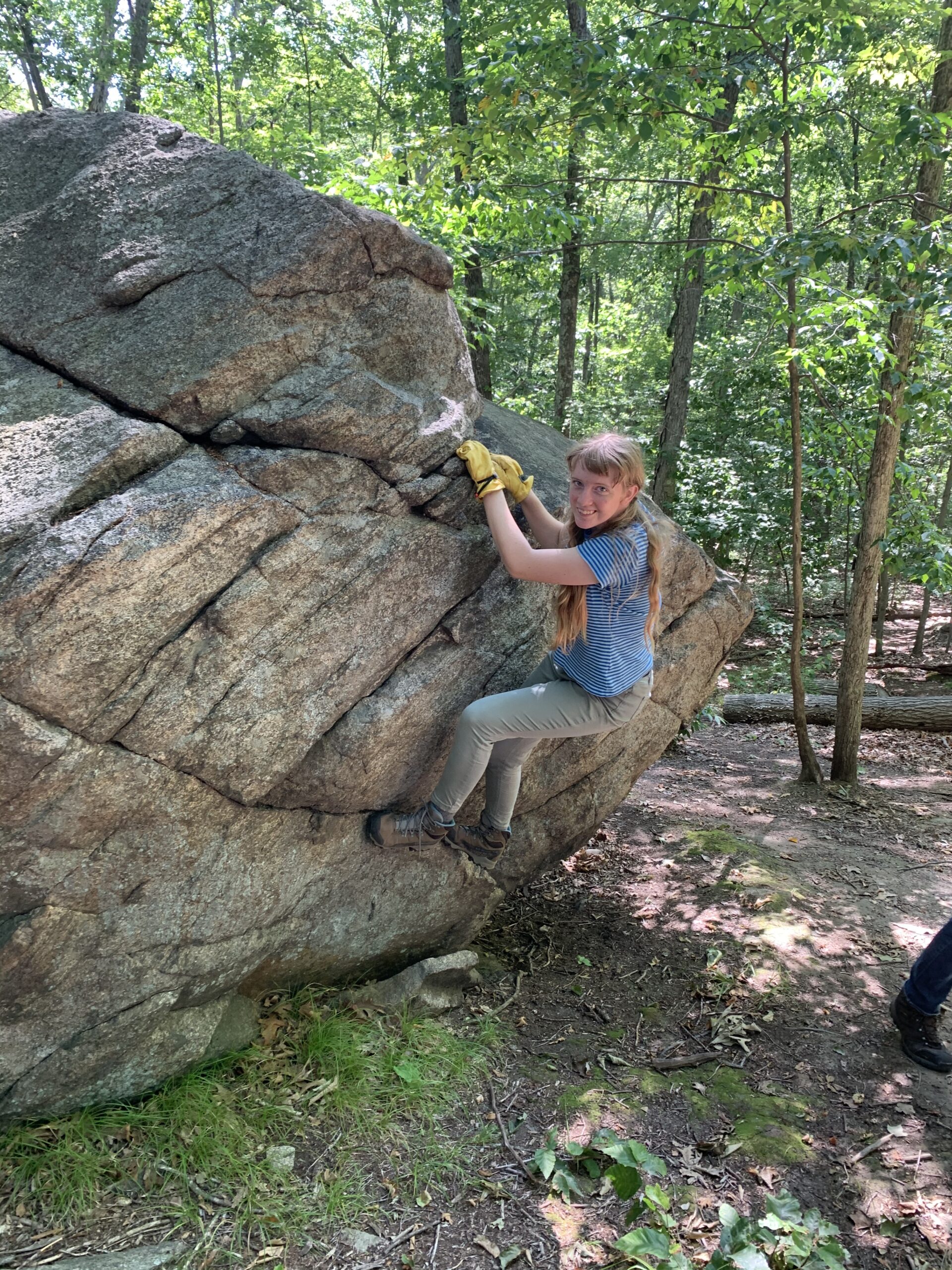 The team had spent 4 weeks giving their best efforts and attitudes so we felt the last day should be more relaxed and reflect our time and projects. After our group lunch, we returned to the office and viewed a documentary pertaining to the state of the natural environment in the past, present, and future. Ultimately we ended the day with a discussion of our time together and provided an opportunity for open discussion about the program as a whole. With input shared, and the first session coming to an end, we said our goodbyes.
The team had spent 4 weeks giving their best efforts and attitudes so we felt the last day should be more relaxed and reflect our time and projects. After our group lunch, we returned to the office and viewed a documentary pertaining to the state of the natural environment in the past, present, and future. Ultimately we ended the day with a discussion of our time together and provided an opportunity for open discussion about the program as a whole. With input shared, and the first session coming to an end, we said our goodbyes.
The first session of the 2022 Internship Program was a tremendous success and the thanks are due to the interns. Anna, Cooper, Elle, Jose, Matthew, and Ned are all outstanding individuals who came together flawlessly to engage as thoughtful stewards of the land. Their continued engagement and enthusiasm throughout the weeks allowed many projects to be accomplished and contributed to the overall well-being of our properties. It is the thoughtful contribution of interns and community members that allows the New Canaan Land Trust to continue our best conservation efforts. A huge thank you is due to Ned, Matthew, Jose, Elle, Cooper, and Anna for all that they did. With the first session concluded, we are very excited here at the Land Trust to move forward with our second session picking up on Monday, July 25. Thank you to all of our New Canaan Land Trust supporters for taking the time to catch up with our internship program. If you ever see our interns out on the trails please feel free to stop and say hello!
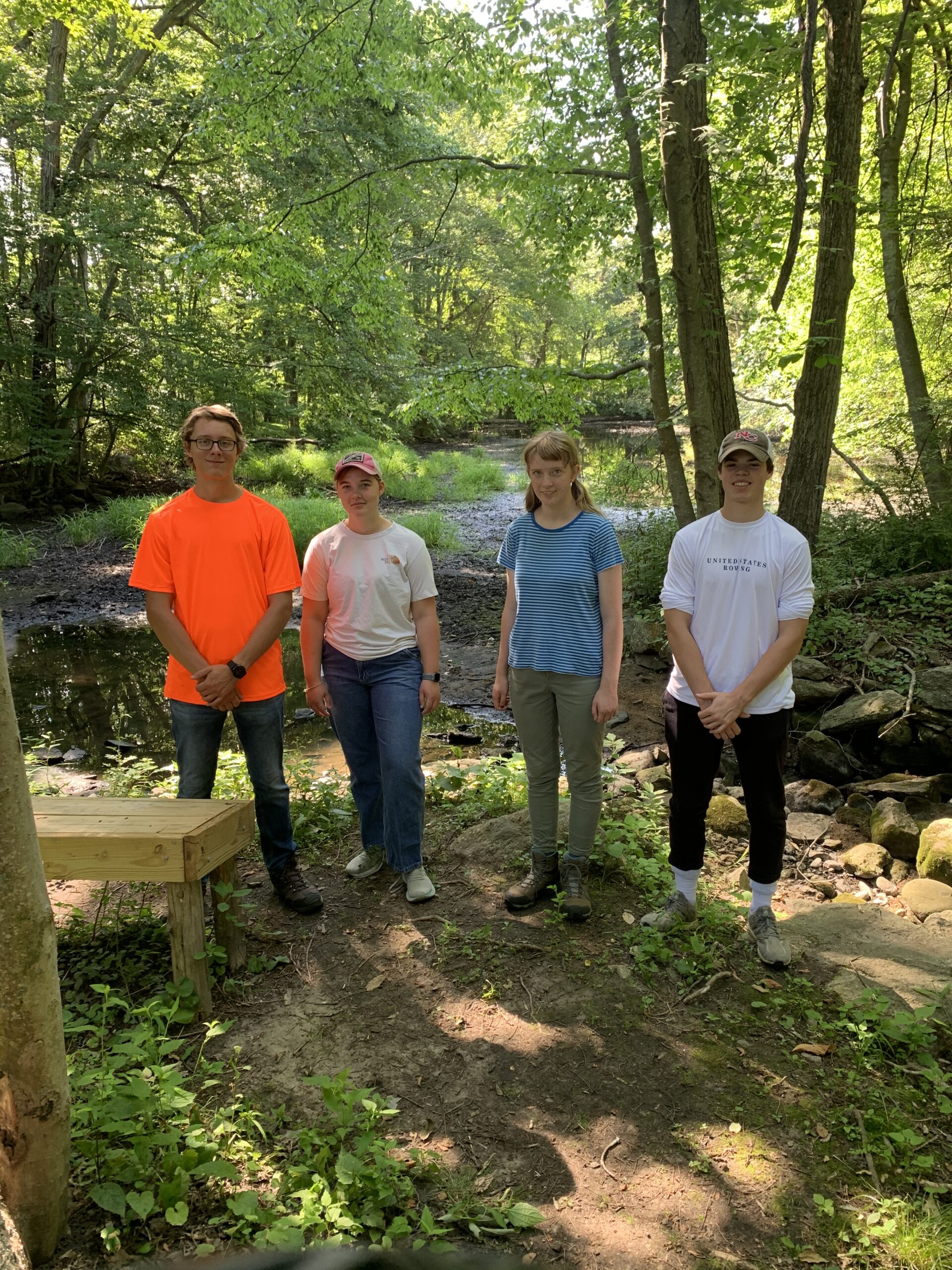
Left to right: Cooper, Elle, Anna, Ned
Your discussion of the week was so informative.
You and your crew did such wonderful work. Congratulations !!
Love all the pics! Looks like a great time!
Love these blog updates! You are all doing such great work for our community. Thank you, Drew!
Well done, Andrew and fellow interns. If we all planted a seed and a sapling each year, both an abundant harvest and countless CO absorbing trees would flourish on our Good Earth and ensure our survival.